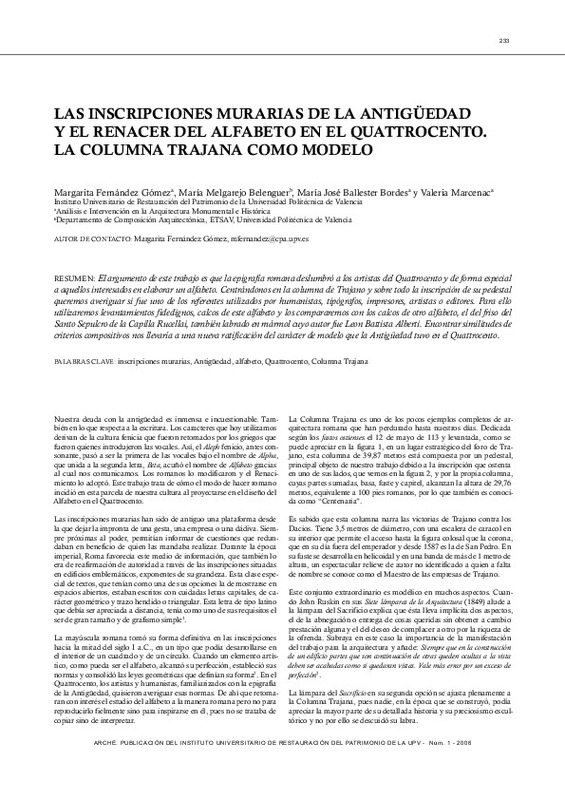JavaScript is disabled for your browser. Some features of this site may not work without it.
Buscar en RiuNet
Listar
Mi cuenta
Estadísticas
Ayuda RiuNet
Admin. UPV
Las inscripciones murarias de la antigüedad y el renacer del alfabeto en el Quattrocento. La columna trajana como modelo
Mostrar el registro sencillo del ítem
Ficheros en el ítem
| dc.contributor.author | Fernández Gómez, Margarita
|
es_ES |
| dc.contributor.author | Melgarejo Belenguer, María Purificación
|
es_ES |
| dc.contributor.author | Ballester Bordes, Mª José
|
es_ES |
| dc.contributor.author | Marcenac, Valeria
|
es_ES |
| dc.date.accessioned | 2013-10-02T12:04:49Z | |
| dc.date.available | 2013-10-02T12:04:49Z | |
| dc.date.issued | 2006 | |
| dc.identifier.issn | 1887-3960 | |
| dc.identifier.uri | http://hdl.handle.net/10251/32536 | |
| dc.description.abstract | El argumento de este trabajo es que la epigrafía romana deslumbró a los artistas del Quattrocento y de forma especial a aquellos interesados en elaborar un alfabeto. Centrándonos en la columna de Trajano y sobre todo la inscripción de su pedestal queremos averiguar si fue uno de los referentes utilizados por humanistas, tipógrafos, impresores, artistas o editores. Para ello utilizaremos levantamientos fidedignos, calcos de este alfabeto y los compararemos con los calcos de otro alfabeto, el del friso del Santo Sepulcro de la Capilla Rucellai, también labrado en mármol cuyo autor fue Leon Battista Alberti. Encontrar similitudes de criterios compositivos nos llevaría a una nueva ratificación del carácter de modelo que la Antigüedad tuvo en el Quattrocento. | es_ES |
| dc.description.abstract | It is defended in this paper that the Roman epigraphy awed the Quattrocento's artists and particularly those who were interested in creating an alphabet. By taking a closer look at the Trajan¿s Column, especially at the inscriptions found on the pedestal, we wished to discover whether this monument was in fact used as a referent by those typographers, humanists, printers, artists and editors. To accomplish this objective, we compared it with other tracings taken from the marble frame of the Holy Tomb of the Capilla Rucelai, by Leon Battista Alberti, by means of a thorough tracing of this alphabet. Finding similarities in composition criteria might be the key for ratifying the model that the Ancient World experienced in the Quatroccento. | es_ES |
| dc.format.extent | 8 | es_ES |
| dc.language | Español | es_ES |
| dc.publisher | Instituto Universitario de Restauración del Patrimonio de la UPV | es_ES |
| dc.relation.ispartof | Arché | es_ES |
| dc.rights | Reserva de todos los derechos | es_ES |
| dc.subject | Inscripciones murarias | es_ES |
| dc.subject | Antigüedad | es_ES |
| dc.subject | Alfabeto | es_ES |
| dc.subject | Quattrocento | es_ES |
| dc.subject | Columna Trajana | es_ES |
| dc.subject | Wall inscriptions of the Ancient World | es_ES |
| dc.subject | Alphabet in the Quattrocento | es_ES |
| dc.subject | Trajan's Column as a model | es_ES |
| dc.subject.classification | CONSERVACION Y RESTAURACION DE BIENES CULTURALES (UPV) | es_ES |
| dc.title | Las inscripciones murarias de la antigüedad y el renacer del alfabeto en el Quattrocento. La columna trajana como modelo | es_ES |
| dc.title.alternative | Wall inscriptions of the Ancient World and the alphabet in the Quattrocento. Trajan's Column as a model | es_ES |
| dc.type | Artículo | es_ES |
| dc.rights.accessRights | Abierto | es_ES |
| dc.contributor.affiliation | Universitat Politècnica de València. Instituto Universitario de Restauración del Patrimonio - Institut Universitari de Restauració del Patrimoni | es_ES |
| dc.description.bibliographicCitation | Fernández Gómez, M.; Melgarejo Belenguer, MP.; Ballester Bordes, MJ.; Marcenac, V. (2006). Las inscripciones murarias de la antigüedad y el renacer del alfabeto en el Quattrocento. La columna trajana como modelo. Arché. (1):233-240. http://hdl.handle.net/10251/32536 | es_ES |
| dc.description.upvformatpinicio | 233 | es_ES |
| dc.description.upvformatpfin | 240 | es_ES |
| dc.description.issue | 1 | es_ES |
| dc.identifier.eissn | 2445-1150 |
Este ítem aparece en la(s) siguiente(s) colección(ones)
-
Arché - Nº 01 : 2006 [44]






